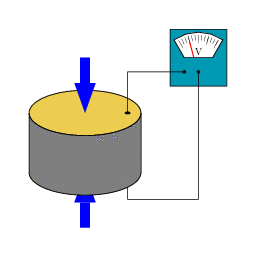Piezoelectrics themselves are not new. In the early 1800's, Pierre and Jacques Curie demonstrated the piezoelectric properties of some natural crystalline materials, such as quartz and sugar cane. What they didn't predict (although they did verify it once Gabriel Lippmann predicted it in 1881) was the converse effect - piezoelectric materials deform when a voltage is applied.

Strange Properties: A piezoelectric material produces a voltage when deformed, and deforms when subjected to a voltage, leading to all kinds of practical applications. The deformation in the diagram is highly exaggerated. Credit: Wikipedia Commons
Both piezoelectric properties have proven to be very useful for practical applications in the years since their discovery. In a direct way, they have been used as high accuracy sensors and actuators. Since a relatively large voltage applied or created by the piezoelectric corresponds to a very small mechanical deformation (often on the order of picometers/volt), piezoelectrics will produce a readable voltage for a very small change in deformation, as is often used in very fine mass balances. They are also used as nanoscale actuators, since the voltage applied need not be very finely controlled to produce a very accurate deformation. Less exotic applications also exist: every computer processor uses a piezometric resonator to provide its clock signal. The constant mechanical deformation of a resonating crystal produces voltage spikes at regular intervals - driving all modern electronic systems.
Recently, however, researchers are trying to exploit piezoelectrics not for their accuracy, but for their power-generation capabilities. Since World War I, piezoelectrics have been used in sonar systems to detect pressure changes in the water and produce a resulting signal voltage, giving valuable information to their operators. But what if that sound could be converted directly into power for the electrical grid? One could imagine freeway walls and medians covered with panels absorbing the sound of passing cars and trucks and feeding it directly into the grid - fulfilling the dual purpose of reducing freeway noise while simultaneously producing energy.
There are applications of this technology already in place - certain dance clubs in Europe utilize dance floors with piezoelectrics to help power the lights. What would really be useful to the consumer, however, would be small piezoelectric systems that could assist in powering personal electronic devices.
Tahir Cagin, a professor in the Artie McFerrin Department of Chemical Engineering at Texas A&M University, has made progress in the development of small piezoelectric power generation devices by finding a specific size of crystal where the efficiency of energy conversion increases by 100%.
Cagin states, "When materials are brought down to the nanoscale dimension, their properties for some performance characteristics dramatically change. One such example is with piezoelectric materials. We have demonstrated that when you go to a particular length scale – between 20 and 23 nanometers – you actually improve the energy-harvesting capacity by 100 percent."
Cagin's research may pave the way to consumer electronics that charge themselves, or perhaps lead to clothing or shoes that can produce electricity for portable devices.
Additional research, done by Orest Symko and a team of graduate students at the University of Utah, converts waste heat into electricity using piezoelectrics. Symko's invention takes heat and produces moving air in a small chamber, which in turn produces a sound wave. The sound wave then hits a piezoelectric material which converts the sound energy into electricity as the sound wave causes it to vibrate. The devices are only a few inches across, and could be used to collect waste heat from electronics or other cooling systems and convert it back into usable energy.
Now that energy has become such a huge political issue in the world, we can expect to see more research into new ways to harness all the lost energy we can and recycle it. With any luck, we'll see cell phones without charging plugs in the near future.





Comments